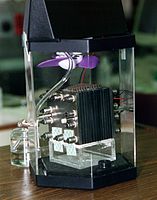
Photo from wikipedia
Abstract Biological sulphate reduction (BSR) represents a sustainable process option for the remediation of low-flow acid rock drainage (ARD) effluents. The linear flow channel reactor (LFCR) was developed as a… Click to show full abstract
Abstract Biological sulphate reduction (BSR) represents a sustainable process option for the remediation of low-flow acid rock drainage (ARD) effluents. The linear flow channel reactor (LFCR) was developed as a semi-passive bioreactor facilitating sulphate reduction and sulphide removal, through the action of sulphate-reducing bacterial (SRB) and sulphur oxidising bacterial consortia, within a single reactor unit. A consensus on key microorganism(s) required within BSR bioreactor consortia for successful operation is still to be reached. In this study next-generation gene amplicon sequencing was used to assess the microbial communities within an anaerobic LFCR supplemented with acetate as the primary electron donor. The performance of this reactor was monitored for over 1000 days throughout a hydraulic retention time (HRT) study and the composition of the microbial communities within this system assessed at several time points. The reactor exhibited a maximum volumetric sulphate reduction rate of 17.8 mg/L.h at a dilution rate of 0.042 h−1. Microbial biofilm communities formed on the incorporated carbon microfibres, as well as planktonic communities showed marked changes in community composition over the course of the study. The presence and shifting abundance of SRBs in the biofilm and planktonic communities that had been identified in previous studies to dominate under defined operating conditions allowed the functional role of individual microorganisms to be elucidated. A Desulfatitalea, whose presence had been previously linked to sulphate scavenging at low sulphate concentrations, was found at high abundance at long residence times. Conversely, a Desulfobacter which was previously shown to dominate under conditions of high sulphate loadings and associated high reaction rates and high substrate concentrations was found at a high dilution rate and low residence time in both the planktonic and biofilm communities. Assessment of the microbial communities and overlaying of performance within this system has enabled us to provide a preliminary link between the structure of the microbial community and the performance of this BSR reactor system. These findings provide considerable insights into the improved design and operation of acetate-supplemented BSR reactors to ensure successful performance.
Journal Title: Hydrometallurgy
Year Published: 2020
Link to full text (if available)
Share on Social Media: Sign Up to like & get
recommendations!